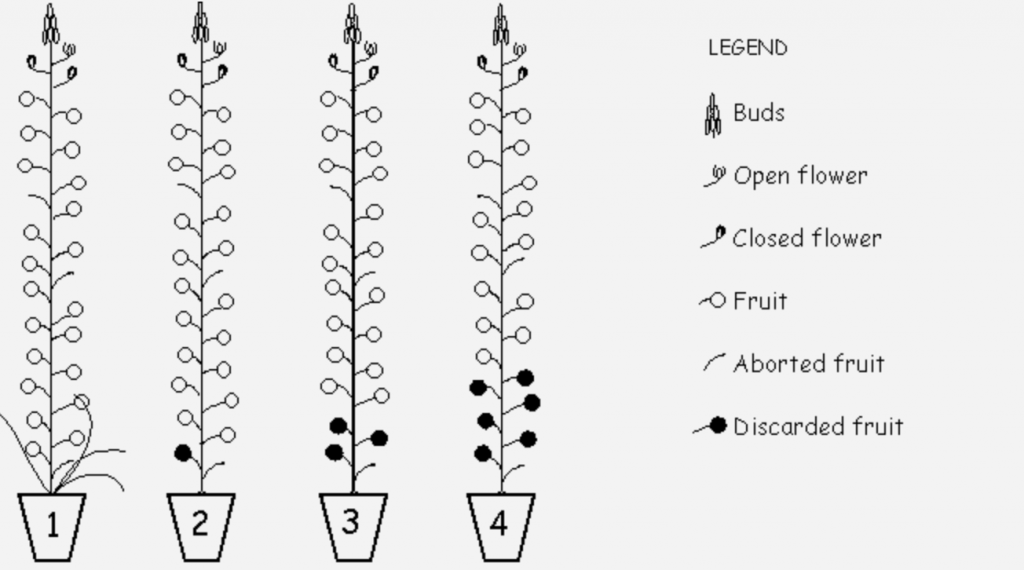Harvesting native lilies – Background
Harvesting seeds from bulbine bulbosa
Bulbine bulbosa is a perennial lily native to grasslands in eastern and southern Australia. It has grass-like leaves growing from a compressed stem or bulb. In the wild it produces leaves in autumn, followed in spring by one or more unbranched flowering stems. In cultivation, mature fruit produces from one to thirteen black, angular seeds. The fruit mature sequentially from the base of the stem. Usually one to three fruit open on a stem on one day. It is common for shedding fruit, immature fruit, two or three open flowers and unopened buds to be present on the one stem at one time.
Harvesting seed efficiently from Bulbine bulbosa is difficult. Once each fruit opens the seed is easily dislodged. A high recovery of mature seeds can be achieved by hand harvesting fruit every one to three days just prior to their opening and shedding their seed. But hand harvesting is tedious and time consuming. An alternative may be to harvest intact stems, allow them to dry, and recover the seed when it falls from the dried fruit. Although fewer seeds might be collected using the alternative method, the method might still be worthwhile because of the saving in time.
With the range of reproductive stages up a given stem, it was not obvious when to harvest each stem, nor to what extent seed would continue to develop and mature once a stem was cut from the plant and allowed to dry. The experiment investigated the influence of harvest method of Bulbine bulbosa on total seed yield and seed size. The conventional hand harvesting method, where stems remained on the plant and fruits were harvested as they reached harvest maturity, was compared to storing harvested stems in a controlled environment.
Objective
To investigate the influence of harvest method of Bulbine bulbosa on seed yield and seed size.
Harvest treatments
Bulbine bulbosa plants were grown to maturity in standard nursery containers, one plant to a container. In December 1996, plants were selected. The selection criteria were that each plant had at least one stem that had set twenty or more fruit and that the oldest (lowest) fruit on that stem was approaching harvest maturity. Plants were randomly allocated to one of four treatments, with ten plants in each treatment.
The four treatments were:
- Fruit were harvested as each reached harvest maturity (hand harvest);
- Stems were harvested when the first fruit was at harvest maturity (early harvest);
- Stems were harvested when the third fruit reached harvest maturity (intermediate harvest);
- Stems were harvested when the sixth fruit reached harvest maturity (late harvest).
The plants were placed on a nursery trolley in a completely randomised arrangement and hand watered for the duration of the experiment.
For treatment 1, each fruit was hand harvested as it reached harvest maturity. For stems in treatments 2, 3 and 4, the first, the first three and the first six fruit respectively, were not counted as part of the harvest. However, the seeds from these fruit were collected and counted as they represented seeds lost from the harvest for these treatments.
At harvest commencement, the following information was recorded for each stem:
- number of fruit aborted;
- number of fruit (including those that will be discarded in treatments 2, 3 & 4);
- number of open flowers;
- number of unopened buds.

maturities (treatments 2,3 & 4). Fruit depicted as solid were discarded from the harvest count.
For stems in treatment 1, all open flowers and buds were retained on the stem and were allowed to develop normally, as would be the case in a sequential, nondestructive harvest.
For stems in treatments 2, 3 and 4, all unopened buds above the topmost open flower were removed at harvest. While this differed from the method for treatment 1, the buds were removed on the assumption and prior observation that they would not set fruit, once detached from the plant.
Harvested stems were tied to bamboo stakes with twist tie. This arrangement kept the stems straight and stable. They were placed upright in a controlled environment cabinet set at 20oC, with 16 hours light and 8 hours darkness in each 24 hour cycle. The stems were placed upright to allow for the analysis of the seed yield of each fruit at harvest maturity. In practice, it is likely that detached stems would be dried in bunches and held upside-down, with the seed falling into a collector as the fruit opened.
As fruits reached harvest maturity they were removed from the stem. Harvested seeds were stored in paper envelopes.
Seeds were screened into three category sizes using 2mm, 1.5mm and 1.2mm sieves. Large seeds were those retained by the 2mm sieve. Medium size seeds were those retained by the 1.5mm sieve, and small seeds were retained by the 1.2mm sieve. Seeds passing through the 1.2mm were essentially undeveloped and were disregarded; these seeds are irrelevant and were not counted in the variable ‘Number of discarded seeds’.